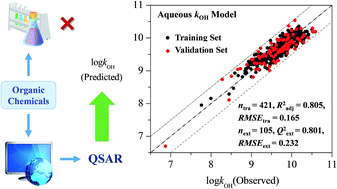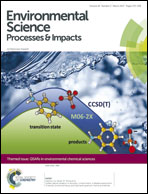Development of a QSAR model for predicting aqueous reaction rate constants of organic chemicals with hydroxyl radicals†
Abstract
Reaction with hydroxyl radicals (˙OH) is an important removal pathway for organic pollutants in the aquatic environment. The aqueous reaction rate constant (kOH) is therefore an important parameter for fate assessment of aquatic pollutants. Since experimental determination fails to meet the requirement of being able to efficiently handle numerous organic chemicals at limited cost and within a relatively short period of time, in silico methods such as quantitative structure–activity relationship (QSAR) models are needed to predict kOH. In this study, a QSAR model with a larger and wider applicability domain as compared with existing models was developed. Following the guidelines for the development and validation of QSAR models proposed by the Organization for Economic Co-operation and Development (OECD), the model shows satisfactory performance. The applicability domain of the model has been extended and contained chemicals that have rarely been covered in most previous studies. The chemicals covered in the current model contain functional groups including ![[double bond splayed left]](https://www.rsc.org/images/entities/char_e009.gif) C
C![[double bond, length as m-dash]](https://www.rsc.org/images/entities/char_e001.gif) C
C![[double bond splayed right]](https://www.rsc.org/images/entities/char_e00a.gif) , –C
, –C![[triple bond, length as m-dash]](https://www.rsc.org/images/entities/char_e002.gif) C–, –C6H5, –OH, –CHO, –O–,
C–, –C6H5, –OH, –CHO, –O–, ![[double bond splayed left]](https://www.rsc.org/images/entities/char_e009.gif) C
C![[double bond, length as m-dash]](https://www.rsc.org/images/entities/char_e001.gif) O, –C
O, –C![[double bond, length as m-dash]](https://www.rsc.org/images/entities/char_e001.gif) O(O)–, –COOH, –C
O(O)–, –COOH, –C![[triple bond, length as m-dash]](https://www.rsc.org/images/entities/char_e002.gif) N,
N, ![[double bond splayed left]](https://www.rsc.org/images/entities/char_e009.gif) N–, –NH2, –NH–C(O)–, –NO2, –N
N–, –NH2, –NH–C(O)–, –NO2, –N![[double bond, length as m-dash]](https://www.rsc.org/images/entities/char_e001.gif) C–N
C–N![[double bond splayed right]](https://www.rsc.org/images/entities/char_e00a.gif) ,
, ![[double bond splayed left]](https://www.rsc.org/images/entities/char_e009.gif) N–N
N–N![[double bond splayed right]](https://www.rsc.org/images/entities/char_e00a.gif) , –N
, –N![[double bond, length as m-dash]](https://www.rsc.org/images/entities/char_e001.gif) N–, –S–, –S–S–, –SH, –SO3, –SO4, –PO4, and –X (F, Cl, Br, and I).
N–, –S–, –S–S–, –SH, –SO3, –SO4, –PO4, and –X (F, Cl, Br, and I).

- This article is part of the themed collection: QSARs and computational chemistry methods in environmental chemical sciences


 Please wait while we load your content...
Please wait while we load your content...